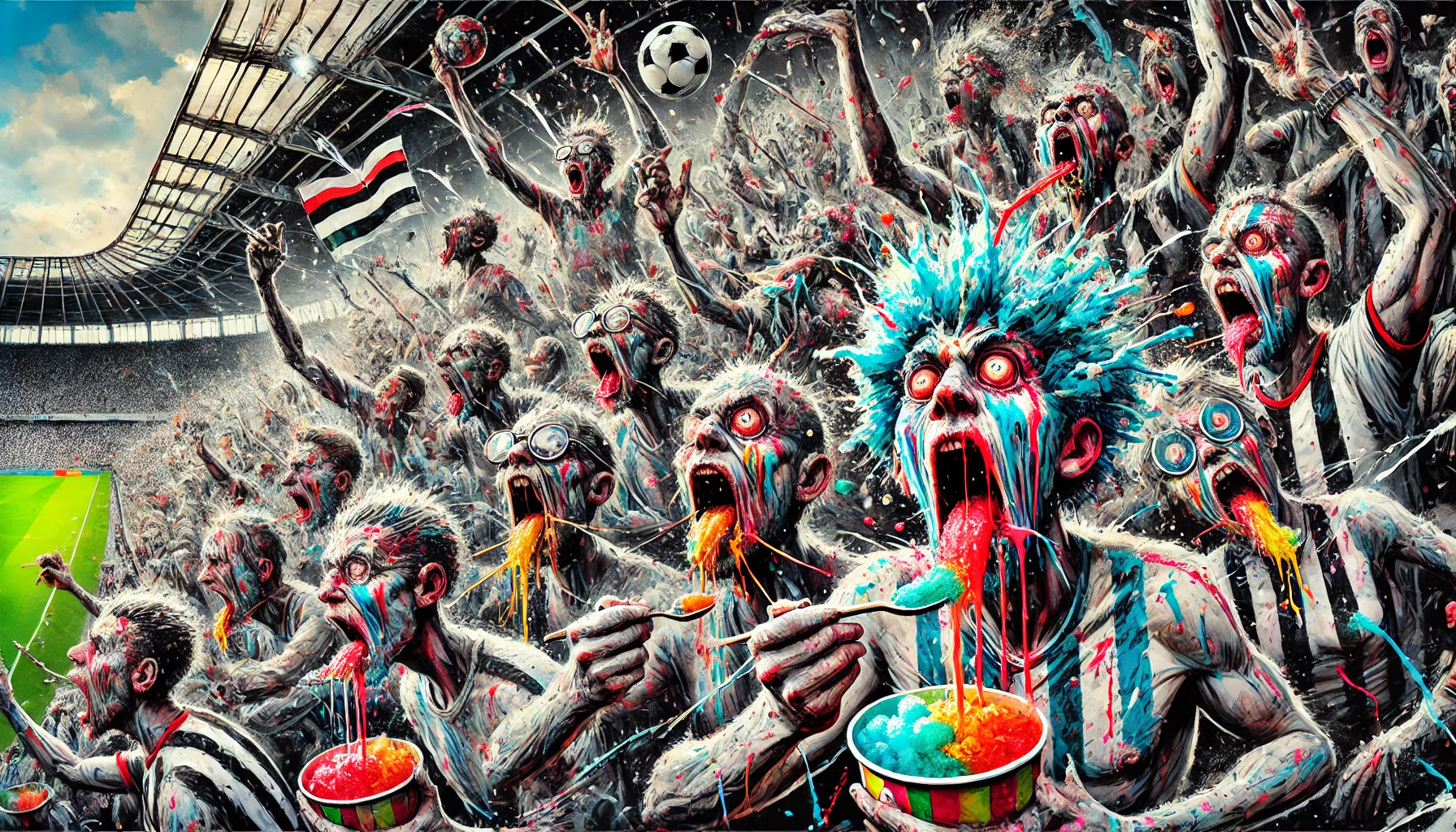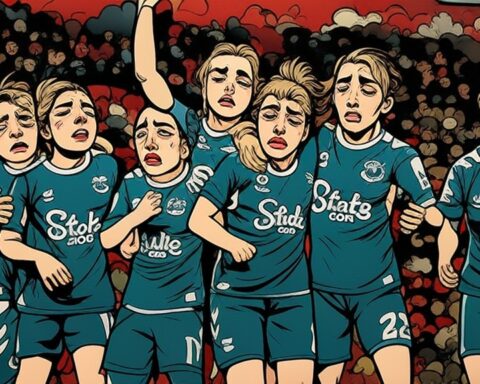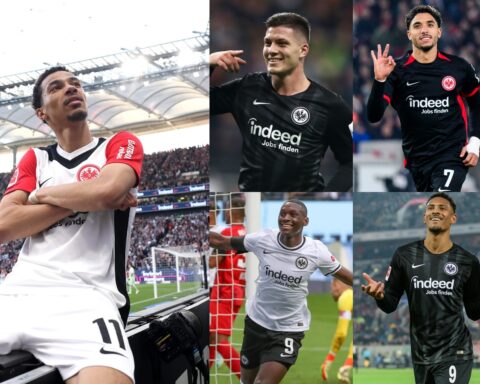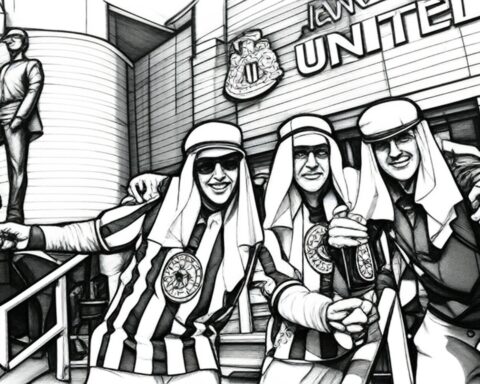Football and drugs. Two elements of modern life that have been inextricably linked for decades, both feeding into each other like a never-ending ouroboros of excess, delirium, and chaos.
If there is a place where the manic energy of drug culture and football fandom collide, it’s in the concrete cauldrons of stadiums, on the rain-slick streets outside pubs before a match, in the manic euphoria of an away day gone too far.
You can smell it in the air, drifting through the turnstiles with the acrid stench of cigarettes and warm beer.
It’s in the frenzied eyes of the lads hopped up on cocaine, jaws grinding like faulty machinery. It’s in the lost souls on the terraces, numbed by cheap pills, searching for meaning in the ebb and flow of a match that seems to echo the unpredictable highs and lows of a bad trip.
But this is not just about the fans. The connection between football and drugs is deeper, more insidious, stretching from the streets to the pitch itself.
Players, fans, and entire cultures have been shaped by the strange, undeniable allure of narcotics.
The Culture of the High: Drugs in Football Fandom
Football has always been about escape. For the working-class faithful who fill the stands, football offers a momentary reprieve from the grinding, joyless monotony of everyday life.
And what better way to enhance that escape than with chemicals designed to numb, distort, or amplify reality?
From the hooligan-fueled days of the 70s and 80s, where lager and amphetamines fueled chaotic street battles, to the ecstasy-laden terraces of the 90s, when the rave movement seeped into the game like an uncontrollable tide, drugs have been a constant companion to football culture.
Today, it’s cocaine—white, rampant, unrelenting. Every weekend, train stations and city centers across England become hotbeds of twitchy, bug-eyed groups, gathered for the weekend’s ritual: a few pints, a few lines, then the stadium.
The numbers don’t lie. A 2019 survey found that cocaine use at football matches had skyrocketed, with fans openly racking up lines in stadium toilets, pubs, even on the terraces themselves.
The drug fuels the atmosphere—heightening aggression, creating a frantic energy that pulses through the stands.
Some embrace it, feeding off the manic buzz. Others recoil, watching in horror as formerly raucous but controlled atmospheres become feral, barely contained chaos.
Yet, it’s not just the uppers. Ketamine has crept into football fandom in recent years, a depressant creating strange, disjointed groups of fans stumbling through concourses, trapped in their own minds as the game plays on around them.
Weed, once the outsider’s drug, is now a staple for those seeking a calmer matchday experience, a counterbalance to the unrelenting pace of the modern game.
Drugs on the Pitch: Players and Their Vices
If drugs have long been embedded in football fandom, they have just as firm a grip on the game itself.
Stories of professional footballers indulging in narcotics are whispered in hushed tones, the full extent of their drug use hidden behind PR shields and club spin machines. But the cracks are always visible.
Diego Maradona, a god among men, a footballing deity who flew too close to the sun and tumbled back to Earth, his career intertwined with cocaine and excess.
Paul Merson, an intoxicating talent both on and off the pitch, lost in a haze of alcohol, gambling, and Class A substances. Adrian Mutu, whose career crumbled under the weight of a failed drug test, his once-bright star extinguished.
But this is not just a tale of excess and downfall. The modern game is a high-performance machine, a world where players are expected to push their bodies to superhuman limits.
And with that comes the darker side of drug use—performance enhancers, painkillers, substances designed not to entertain, but to sustain.
Behind closed doors, an unspoken truth lingers. Players are pumped with painkillers to mask injuries, cortisone injections to keep them running on broken bodies.
Some turn to stimulants, seeking the extra edge that separates elite athletes from the merely great. The world of professional football is not immune to the pressures of chemical assistance—it thrives on it.
A Reflection of Society
Football, like drugs, is a mirror held up to the world. The game reflects the culture that surrounds it, and in England—a nation where cocaine use is soaring, where addiction is both glamourized and vilified, where working-class communities are left to rot while corporations rake in billions—it is no surprise that the sport is riddled with the same problems.
Fans turn to drugs for the same reason society does: escape. Escape from a world that feels increasingly detached, cold, and unwelcoming.
The rise in drug use at football matches is not just about hedonism or violence—it is about searching for something real, something visceral, in a world that often feels numb.
And yet, the authorities treat it as a problem of individuals rather than systems. More searches at stadiums, more bans, more crackdown measures—none of which address the deeper issues.
The corporate takeover of football, the sterilization of atmosphere, the ever-rising ticket prices—all of these factors push fans further towards artificial highs in search of the passion that once came naturally.
The Future of Football and Drugs
As football continues to morph into an unrecognizable spectacle of sanitized branding, soulless mega-stadiums, and corporate detachment, the relationship between the sport and drugs will only evolve further.
What happens when the very thing that made the game special—the chaos, the tribalism, the raw, unfiltered emotion—is drained away? What fills the void?
The answer is already there. A line on a toilet seat. A pill under the tongue. A desperate attempt to claw back something that has been lost.
Football and drugs. Two forces destined to remain entwined. The beautiful game and the ugly reality, locked together in an endless, manic embrace.













Follow Me